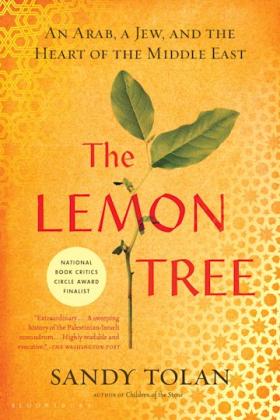An Arab, a Jew, and the Heart of the Middle East

Reviewed by James Finck, Ph.D. | Southwest Ledger
For about the last 10 years, whenever I am asked what book I would recommend, I have always given the same answer: The Lemon Tree: An Arab, a Jew, and the Heart of the Middle East.
Not only does The Lemon Tree try to explain one of the most difficult questions of the past 70 years in a nonbiased way, but its principles can be used to analyze serious disagreements today.
When dealing with the Middle East, the most difficult subject to comprehend is the Israel-Palestine relationship. At the heart of any discussion is who is to blame for the problem and how is it solved. The simple answer to this is I don’t know. Both sides have their share of the blame.
In The Lemon Tree, Sandy Tolan tells the true-life story of two people – a Jew and a Palestinian – who become part of each other’s life. Along the way Tolan explains in fine detail the struggle between the two people. He does not have answers either, but we at least can understand each side better.
The Lemon Tree tells the story of the Khairi family, an important Palestinian family in Ramallah. In 1948, the Khairi family was forced from the home they built by Israeli soldiers during the Israeli War of Independence and became refugees along with thousands of Palestinians in the West Bank.
At the same time the Eshkenazi family, a Jewish family after having survived the Holocaust in Bulgaria made the trip to Zion. The Eshkenazis were excited to be part of the Zionist movement which created a land for people who did not have any and promised them the security they had craved for for so long. When they arrived in Israel, they were sent to Ramallah and given a nice house to make into a home.
One of the features the young Dalia Eshkenazi remembers when she arrived was the lemon tree in the back yard. She grew up in the house never really questioning who owned it before her or why, as she was told, the previous family would abandon it. Everything changed for Dalia while she was home from college and there was a knock at her door. Standing in front of her were three Palestinian young men. One of them was Bashir Khairi, who along with his two cousins had come to see his home after 19 years. As Dalia allowed them in, she not only started a new friendship but a new journey of discovery that opened her eyes to the treatment and hardships of the Palestinians.
Each would try to explain to the other their story. Bashir’s only dream was to return to his home and his land, while Dalia’s was to have a land and security. The problem was neither could have their dream a reality at the same time. Bashir went on to become part of the resistance of Israel and spent more than 17 years in and out of jail. Dalia tried to understand his struggle, but also struggled herself with his possible role in what she saw as terrorism, but Bashir saw as freedom.
The story of Dalia and Bashir brings a humanity and a face to this difficulty and helps shed a light on the struggle of those having to deal with the problem every day.
When speaking with Bashir’s family Dalia thought, “It is either us or them? Either I live in their home while they are refugees, or they live in my house while I become a fugitive? There must be another possibility. But what is it?”
Finally, while the current division in America is no where on the level of the Israeli-Palestinian conflict, we can learn from their struggle. One of my favorite passages comes from a conversation between Dalia and Bashir’s family. Dalia understood their pains and even admitted that their expulsion was wrong but asked how another mistake would make the first one better.
Dalia went on to say, “I’m not going to explain to you what the yearning for Zion means to us. I will just say that because you see us as strangers in this land, that is why we are afraid of you. You should not think that I myself am free of fear. I have a good reason to be afraid: The Palestinian people as a collective have not accepted the Jewish home in this land. Most of you still consider us a cancerous presence among you. I struggle for your rights despite my fears. But your rights have to be balanced against our needs for survival. That is why you cannot be satisfied. For you, every viable solution will always be lacking in justice. In a peace plan, everybody will have to do with less then they deserve.”
As we drift further apart, Americans eventually need to understand that everyone’s rights must be respected, even those with whom we disagree. In Israel, that means both nations have the right to exist. While in America, that might mean the right to a different opinion.
Tolan writes the book like a novel but does not take license on the characters’ feelings. The story is thoroughly researched, brilliantly written and is a must-read for anyone wanting to understand the Middle East or possibly even humanity.
James Finck, Ph.D. is a professor of history at the University of Science and Arts of Oklahoma. He can be reached at Historicallyspeaking1776@gmail.com.


